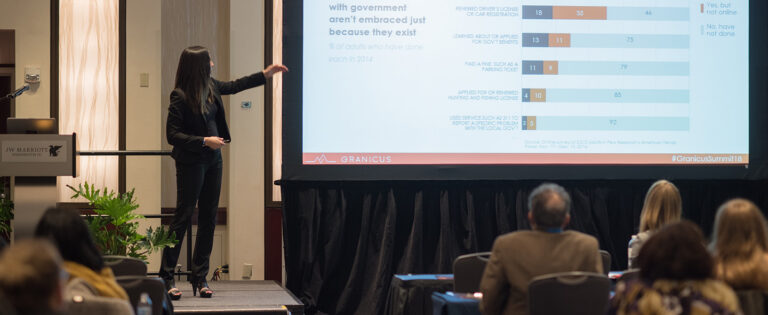
It’s all very well building a shiny new portal or slick website that promises an easy customer experience AND efficiency savings for your organisation, but what if no one knows it exists? What if it goes unused?
These were questions asked during the “If You Build It, Will They Come?” workshop at the 2018 Granicus National Summit hosted by Tina Burgess, Product Marketing Manager at Granicus.
Having a plan for how you’re going to engage existing and new audiences in your beautiful, new digital offering—and then get them to use it in the desired way—is as important as building the service itself. Plan early and execute your communications strategy in tandem with the rollout of your new service.
Whether you’re trying to increase the number of people booking their flu shots online, finding out about pet adoption opportunities, or buying fishing and hunting licenses online, just digitizing a service doesn’t make it a success. You must go TO your target audience and lead them to your services, especially if your organization needs to realize significant cost and time-saving targets as a result of channel shifting customers away from analog or high-cost contact channels to cost-effective channels online.
“A recent survey showed that only 27 percent of citizens accessed government-operated leisure activities online despite a digital capability. Many people didn’t even know about it. It’s always important to consider the ‘rule of seven’ which means people on average need to hear something seven times before they really grasp, understand and internalize a message.” —Tina Burgess, Granicus
Communicators must share information about the new opportunity in different ways across different platforms multiple times to have a chance of resonating with an audience. And without the luxury of a big communications budget, government organizations must work harder to be strategic in their approach to “spreading the word”.
While analogue approaches (flyers, posters and mailings) may be “right” for some audiences, they incur significant print and distribution costs which are probably not sustainable for your team. They can also be difficult to track which presents a problem for measuring returns on marketing investment (ROMI).
However, when the average American spends six hours a day on digital devices and checks their phone once every 12 minutes (80 times a day), digital channels are a huge opportunity for agencies to connect with more citizens where they’re comfortable spending time and already consuming content.
Seven steps to better citizen engagement that helps drive program success:
When trying to engage audiences in a new service or opportunity, plan how you’ll use digital communications and promotion tactics to drive take-up:
Branding consistency across all platforms and collateral is key to driving recognition, trust and understanding of your service or the opportunity you’re sharing. Instead of calling your service “County’s new outdoor licensing portal” for example, give it a more memorable identity such as “Go Wild”. With that, you have an opportunity to use a bespoke logo, strapline, colors and other brand indicators to drive awareness.
Build a “REACH > AWARENESS > ENGAGEMENT” comms plan. Be deliberate about your choice of tactics, and ensure they are right for your target audience. Even if you use analogue channels to capture audience information (postcards and paper forms etc), consider whether you need to gather their email address as well to help future-proof your audience engagement activity. How long will your agency be able to continue communicating through print? Furthermore, don’t just “send out stuff” and hope something “sticks”. Be careful, be strategic. Test what works and be prepared to adapt.
Use all relevant channels available to you to capture new audiences. Promote your new service in high-traffic areas on your website and partner websites, use a web overlay to capture more subscribers/customers, and cross-promote wherever you can to engage new community members. Don’t just “fish” from the same old pool. Think bigger and collaborate with other stakeholders.
Segment your audience and deliver different messages for each “buyer persona” according to their demographic characteristics; you stand a better chance of capturing someone’s attention through your communications and moving them to take the desired action. Plan in advance what demographic variables will be involved in your segmentation strategy to ensure you’re capturing the right audience data at the point of their subscribing to your service/digital updates.
Make sure your messaging speaks directly to your audience’s needs, not those of your organization. Spell out the benefits to make your audience care about this new offering and feel as though they’d be missing out on something important. Consider the language you’ll use to convey these benefits succinctly: “Buy any time, anywhere,” “Renew your license on your phone right now,” “Buy online to save on your print costs,” etc. Break down the motivations by persona and target your messages accordingly.
Use a reputable marketing automation tool to ensure your messages get through to your audience. A platform such as the GovDelivery Communications Cloud by Granicus that works exclusively with government and public sector teams can help guarantee your important comms don’t get stuck in spam filters. Can you afford for your comms to have a poor deliverability rate!? Using a reliable tool not only helps deliver messages to more of the right people, a 99-plus percent average deliverability rate will also make the best of your time spent and maximize the impact.
Monitor what’s working and what’s not and be prepared to adapt your communications. Use automated A/B testing for your subject lines, images, language and other design considerations to deliver the most impactful message to the biggest audience. Messages that achieve higher open and click rates have the potential to drive more people to take the desired action, so incremental improvements really do matter.